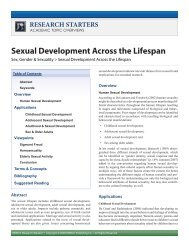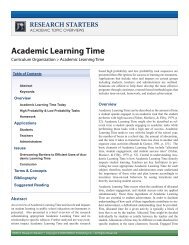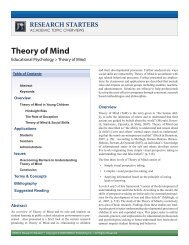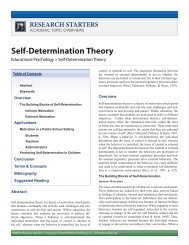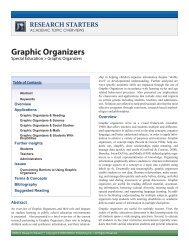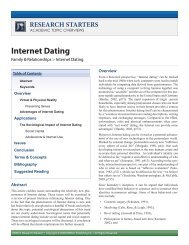Social Status & Social Interaction - DSWLeads.com
Social Status & Social Interaction - DSWLeads.com
Social Status & Social Interaction - DSWLeads.com
You also want an ePaper? Increase the reach of your titles
YUMPU automatically turns print PDFs into web optimized ePapers that Google loves.
RESEARCH STARTERSACADEMIC TOPIC OVERVIEWS<strong>Social</strong> <strong>Status</strong> & <strong>Social</strong> <strong>Interaction</strong>Day to Day <strong>Social</strong> <strong>Interaction</strong> > <strong>Social</strong> <strong>Status</strong> & <strong>Social</strong> <strong>Interaction</strong>Table of ContentsAbstractAbstractKeywordsOverview<strong>Social</strong> <strong>Status</strong>ValidationMembership & <strong>Social</strong> Identity<strong>Social</strong> <strong>Interaction</strong> & Well-Being<strong>Social</strong> <strong>Status</strong> & <strong>Interaction</strong>Group <strong>Interaction</strong>ApplicationsLow Self-Esteem & <strong>Social</strong> RejectionViewpointsPopularity & <strong>Social</strong> AdjustmentConclusionTerms & ConceptsBibliographySuggested ReadingFactors that play a role in constructing one’s social status varyand research will be presented in this article that is intended toincrease social meaning and relevance. Insights will also be presentedinto ways social status impacts interaction in individual,group, and inter-group memberships. Applications regardingsocial status and interaction are offered through the lens of lowself-esteem and age factors. A conclusion is presented suggestingimplications for further research into the relevance of socialstatus and its subsequent impact on social interaction.Overview<strong>Social</strong> <strong>Status</strong><strong>Social</strong> status can be defined as the rank or placement of an individualin society. <strong>Social</strong> status can potentially be determinedthrough stratification systems. <strong>Social</strong> stratification system theoriesare often multi-level and predictive of ways structural effectsinteract with <strong>com</strong>munities and the poor (Wolf, 2007). Wolf(2007) further argued that the relationships within this systemare contingent upon the effects of social isolation; socially isolatedindividuals may lack access to others or to human capital,resources, and influence. Arguably, limited resources result inthe “lack of access to different kinds of human and social capital,such as financial resources, education, and peer role models…,”ultimately resulting… “in a change in <strong>com</strong>munity values andaspirations” (p. 53 – 54). These <strong>com</strong>ponents interplay in formingclass systems operating within these sociological systems.Weber (1978) [1920] indicated that ‘class’ means all persons inthe same class situation. He defined social classes as follows:• A ‘property class’ is primarily determined by propertydifferences;• A ‘<strong>com</strong>mercial class’ by the marketability of goodsand services;• A ‘social class’ makes up the totality of those classsituations within which individual and generationalmobility is easy and typical (p. 302).Smith (2007) indicated that contemporary sociology offers opportunitiesfor social mobility, which can be understood as “breakingthrough the boundaries of social classes” (p. 91). Smith interpretedWeber’s definition of class, and wrote that “a social class isnot a class at all unless mobility takes place within its borders and,crucially, this type of social mobility does not therefore underminethe existence of social classes, but rather defines what these classesare” (pp. 88 – 89). Nesbit (2006) further argued: “Whether we likeit or not, at individual, <strong>com</strong>munity, and societal levels, everythingwe believe and everything we do is influenced by our place in aneconomic and social order” (p. 172). Nesbit further indicated thatEBSCO Research Starters ® • Copyright © 2009 EBSCO Publishing Inc. • All Rights Reserved
<strong>Social</strong> <strong>Status</strong> & <strong>Social</strong> <strong>Interaction</strong>Essay by Sharon Link, Ph.D.Keywords<strong>Social</strong> Class<strong>Social</strong> Competence<strong>Social</strong> Identity<strong>Social</strong> <strong>Interaction</strong><strong>Social</strong> Mobility<strong>Social</strong> <strong>Status</strong>Socio-Emotional Selectivity Theoryeconomic, social, and cultural factors profoundly influence howwe live and what we do, and these factors operate within the structuresof human societies and human relationships.Moreover, these factors dictate ways we “ac<strong>com</strong>modate or resistunfairness and oppression,” and our own thoughts regardingthese phenomena are both limited and enabled by “our place inthe economic structure of society” (p. 172). Body image has alsobeen reported as one factor in obtaining positive social status.Reis, Wheeler, Spiegel, Kernis, Nezlek, and Perry (1982) suggestedthat more physically attractive people rely on their physicalattractiveness to gain social influence. As a result, individualswith more physical attractiveness may use their attractivenessto gain social status and thereby improve their group influence.(Nezlek, 1999, p. 796).ValidationAccording to Tyler (1994), individuals value their group status,because high status validates self-identity, self-esteem, and selfrespect.Validation from others causes individuals to continuallyseek information that confirms that they have a respected positionin the group (Diekmann, Sondak,& Barsness, 2007, p. 163).Perceptions of self-status indicate an individual’s perceptions oftheir own regard and approval they receive from others (VanProoijen, Van den Bos, & Wilke, 2002). According to the “groupvalue model of procedural fairness” (Lind & Tyler, 1988) and theclosely aligned relational “model of authority” (Tyler & Lind,1992), individuals want to understand, establish, and maintainthe social bonds that exist between them and others in theirgroup (Tyler, 1994). The treatment that individuals receive in agroup enable them to infer their status in a group; for example,if the treatment they receive is respectful and fair, individualsperceive they have a high status in the group. On the other hand,if individuals are treated disrespectfully or unfairly, they inferthat they have low status in a group. Information regarding groupstatus subsequently impacts individuals’ reactions to proceduralfairness (Tyler, 1989; 1994; Van Prooijen et al., 2002). Thus, perceptionsof status affect how individuals react to fair or unfairprocedures and treatment (Nezlek, 1999).Membership & <strong>Social</strong> IdentityThrough another lens, Nezlek and Smith (2005) argued thatthe world can be viewed through “in-groups and out-groups, orgroups to which we do or do not belong.” To the extent that groupmemberships determine an individual’s internalized self-conceptimplies our sense of self or what Tajfel and Turner (1986) termed“social identity.” While additional research needs to be conductedregarding social identity in terms of understanding social interaction,past research has indicated that “[social identity] unfoldsin naturally occurring social interaction” (p. 243).<strong>Social</strong> <strong>Interaction</strong> & Well-Being<strong>Social</strong> interaction can be described as an interchangeablesequence of dynamic exchanges through which individuals canattach meaning, intepret, and respond. <strong>Interaction</strong>s take place inmultiple ways and are impacted by multiple variables. Accordingto Nezlek, Richardson, Green, and Schatten-Jones (2002),the quality and quantity of human relationships supports psychologicalwell-being. Moreover, “people who report having moresatisfying and active social lives tend to report feeling better aboutthemselves and their lives” (p. 57). To support their hypothesisand previous, researched results, Nezlek et al. conducted a studyin which they sampled healthy, older, adult participants utilizinga variant of the Rochester <strong>Interaction</strong> Record (RIR) (Wheeler &Nezlek, 1977). The primary hypothesis guiding the study wasthat well-being would be positively related to the quality of participant’ssocial lives. Using the RIR, participants were chargedwith the task of describing the social interactions they had eachday for two weeks. These daily reports provided measures of thequality and quantity of participants’ daily social interaction andsubstantiated measures of these two characteristics and variousmeasures of well-being.The importance of daily social interaction for the well-beingof older adults was suggested in part by Carstensen’s (1995)“socioemotional selectivity theory.” She argued that “olderadults are more motivated than young people to regulate emotionsduring social interactions,” selecting specific close othersfor interaction, and limiting the size of social networks (Nezlek,et al., 2002, pp. 57 – 78). Other research suggests that the qualityof interaction also relates to well-being. For example, individualswho report lower quality relationships also report lower levelsof life satisfaction (O’Connor, 1995). Similarly, Mullins andDugan (1990) argued that greater satisfaction with the quality ofrelationships is associated with decreased feelings of lonelinessand depression, while other researchers have similarly reportedan increased sense of well being in positive relationships (Fox& Gooding, 1998; Ishii-Kuntz, 1990). Other studies resultingin reported well-being in the elderly have also been reported(Beckman, 1981; Ward, Sherman, & LaGlory, 1984). Similarly,just as research suggested that well-being for older people wasconnected to social constructs, research also suggests that wellbeingis positively related to how socially active the nonelderlyare (O’Connor, 1995) and to the quality of their relationships(Diener & Diener, 1995; McDonough & Munz, 1994).EBSCO Research Starters ® • Copyright © 2009 EBSCO Publishing Inc. • All Rights Reserved Page 2
<strong>Social</strong> <strong>Status</strong> & <strong>Social</strong> <strong>Interaction</strong>Essay by Sharon Link, Ph.D.<strong>Social</strong> <strong>Status</strong> & <strong>Interaction</strong><strong>Social</strong> status directly results from interaction that directly affectsgroup and social identity. Tajfel (1978) stated that social identity“is a part of an individual’s self concept which derives fromhis knowledge of his membership of a social group (or groups)together with the emotional significance attached to that membership”(p. 63). According to Nezlek and Smith (2005), some peopleare born into membership such as in the case of race and gender.Others attain it by actively seeking through clubs and politicalorganizations. The social identity theory then would initiate individualsto “maintain a positive social identity, which in turn leadsto positive evaluations of the self. Group membership allows aperson to reap all of the advantages and positive aspects that areassociated with a particular group, such as status” (p. 244).For example, Harasty (1997) determined that when people wereasked to talk about relevant in- and out-groups, individualsspoke more negatively of out-group members than of in-groupmembers. Additionally, when contributing to an interaction,individuals seemed more likely to attribute out-group members’behavior to more stable, dispositional factors than to unstablesituational factors (Nezlek & Smith, 2005). Hewstone, Rubin,and Wills (2002) indicated that inter-group bias is moderated bya variety of individual, group, and inter-group factors. Individualfactors include identification with the group, mood or education.Group factors include size, status, and power of the group. Intergroupfactors include stability of and/or threat to the inter-grouphierarchy (Nezlek & Smith, 2005).Nezlek and Smith report that the “effects of social identity are notlimited to increasing the self-esteem of group members. Considerableresearch suggests that people’s social identities can havebehavioral implications” (p. 244). They cite Tajfel, Billig, Bundy,and Flament (1971), who determined that a simple division intotwo groups prompted English schoolboys to treat the oppositegroup “less favorably” during task related interactions. Insko andSchopler (1998) learned that when people are assigned to groupsand directed to engage in the “prisoner’s dilemma” task againstanother group, “they behave more <strong>com</strong>petitively and less cooperativelythan when they are not grouped and are told they are playingagainst an individual” (2005, p. 244-45).Group <strong>Interaction</strong>Group interaction has both positive and negative aspects. Forexample, members who interact with other members of thein-group may insure their group identity and benefit from thepositive aspects of that group membership. However, membersof a group involved in group membership and group interactionmay also encounter negative aspects of that group membership,including reputation issues or assumption of conformity (Nezlek& Smith, 2005). Biernat, Vescio, and Green (1996) pointed outthat, “by interacting with the out-group, people may be able toreflect on their in-group’s (perceived) superiority but they mayalso face an attractive, alternative out-group that they may notbe able to join or choose not to join” (Nezlek & Smith, 2005 , p.247). They indicated that while group members may enjoy thepositive aspects of belonging to their groups, they are nonethelessaware of the negative <strong>com</strong>ponents of such membership (p.246). Thus, Nezlek and Smith point out that social interactioneither helps or hinders the pursuit of a positive social identity.Theories about social identity, and social status and interactionmay need to evolve to consider differing factors, such as the“nature of the identity being studied, individual differences inpsychological traits such as social dominance and self-construal,individuals’ status within a group, such as the length of membership,and the dimensions on which judgments are being made”(Nezlek & Smith, 2005, p. 259). Overall, further research intospecific kinds of interactions and social status needs to be conductedin order to better inform present thought. “Perhaps futureresearch can determine how people react to interactions in whichthe social identities of one’s interaction partners is not known,something that allows some conclusion about the relative strengthof these two tendencies” (Nezlek & Smith, 2005, p. 258).ApplicationsLow Self-Esteem & <strong>Social</strong> RejectionOne potential application for better understanding social statusand interaction is in <strong>com</strong>prehending the impact of an individual’slow self-esteem on their own sense of social status. Forexample, individuals with low self-esteem feel lonely (Levin &Stokes, 1986) and socially isolated (Hobfoll, Nadler, & Leiberman,1986). Moreover, research indicates that individuals withlow self-esteem often display insecure, preoccupied or fearfulattachment styles (Brennan & Morris, 1997). These factorsmay also cause individuals with low self-esteem to experienceelevated social anxiety, (Leary & Kowalski, 1993) and theymay in turn question their partner’s feelings for them (Murray,Holmes, & Griffin, 2000). Often more highly attuned to rejectioncues (Nezlek, Kowalski, Leary, Blevins, & Holgate, 1997),such individuals are “dispositionally high in rejection sensitivity”(Downey & Feldman, 1996), are preoccupied with socialacceptance (Harter, Stocker, & Robinson, 1996), are motivatedto avoid social disapproval (Tice, 1993), and are inclined tobehave agreeably towards others (Schuetz & DePaulo, 1996)so they will be liked (Schuetz, 1998). Lastly, individuals withlow self-esteem characterize their past as a series of rejections,and have poor expectations regarding future social acceptance(Leary, Tambor, Terdal, & Downs, 1995; Sommer & Baumeister,2002). Arguably, an individual with low self-esteem may sufferimpaired social interactions.On average, social rejection lowers self-esteem (Leary, Haupt,Strausser, & Chokel, 1998; Leary et al., 2003). To counter thethreat posed by such rejection, individuals with low self-esteemmight be more inclined to shy away from the individuals whoreject them and seek solace from accepting individuals. Indeed,the individual with low self-esteem may initiate a safer interactionmethod, because the possibility of failure is all but precluded.Therefore, this interaction method maintains the interpersonalstatus quo, given that it involves disdaining opportunities topromote social inclusion and raise social status. Specifically,individuals with low self-esteem may perpetuate their impairedEBSCO Research Starters ® • Copyright © 2009 EBSCO Publishing Inc. • All Rights Reserved Page 3
<strong>Social</strong> <strong>Status</strong> & <strong>Social</strong> <strong>Interaction</strong>Essay by Sharon Link, Ph.D.social standing by consistently seeking out only those whoalready accept them, rather than by squarely facing and tryingto win over those who initially reject them. Sadly, individualswith low self-esteem may be handicapped by their lower levelsof self-certainty (Campbell & Lavallee, 1993; Baumgardner,1990), their greater proneness to demoralization (Brown &Dutton, 1995; Sedikides & Strube, 1997), and their suboptimalmood-regulation strategies (Heimpel, Wood, Marshall, & Brown,2002; Rudich, Sedikides, & Gregg, 2006, p. 963 – 964).Popularity & <strong>Social</strong> AdjustmentResearch has suggested that popularity or rejection at early agesseems to be an important predictor of future social adjustment.Abundant support can be provided for the stability of popularand rejected children over time and across settings (Cillessen,Bukowski, & Haselager, 2000). Moreover, popular status predictsfuture social <strong>com</strong>petence, that is, the ability to develop intimaterelationships in adolescence, whereas childhood peer rejectionleads to adjustment difficulties in adolescence and adulthood, suchas aggression, social anxiety, academic failure and school drop-out,delinquency, and psychopathology (Coie, Dodge, & Kupersmidt,1990; Kupersmidt, Coie, & Dodge, 1990; Parker & Asher, 1987).All of these maladjustments represent impairments in social interactionsas a direct result of impaired social status. Clearly, socialstatus impacts daily interaction in numerous ways.ViewpointsOne significant issue regarding social status and interaction isthe derivation from culture to culture based on how social statusis informed and determinants related to appropriate versus inappropriateinteractions. While it may be sociologically relevant tostudy social status and interaction, cultural consideration is onefactor for consideration to elicit culturally framed results. Onesuch example of this situation is presently occurring in Russiaand was described by Zarubina (2008).Zarubina (2008) described multiple ways Russian society haschanged since the beginning of the 1990s. She indicated that theNew Russians are the product of a new interpretation of stratabringing liberal socioeconomic reforms, stratification in termsof property ownership, an ever widening gap between the poorand the wealthy, the rapid collapse of previously held values, thepervasiveness of anomie, and criminalized economic activity.Resultantly, almost as soon as the New Russian came onto thescene in real life, “he was turned into an object of mockery and acharacter in jokes, which indicates that society began to view thephenomenon in the spirit of finding ways to reconcile contradictoryworlds” (p. 97). Contrastingly, while the Old Russia calledfor <strong>com</strong>radeship, solidarity, and mutual assistance in relationsamong people, the New Russian relates to the people around him,those who are close or not so close to him, in strictly pragmaticways. The New Russians’ “rejection of traditional cultural normsis also to be seen in what are perceived as their cynical attitudestoward basic cultural values and institutions such as friendship,love, marriage, and family. For them, the concept of unselfishfriendship simply does not exist at all” (Zarubina, 2008, p. 89).Zarubina (2008) further argued that categories of people formerlyclassified among the elite or the top strata, such as scientists, performers,college and university professors, engineers, militaryofficers, now find themselves, “according to the criteria of materialprosperity and consumption, in the lower class or in fact onthe brink of poverty” (p. 93). Class mobility and changing stratificationhas resulted in feelings of mutual hatred, mixed with afeeling of superiority. Increasing jokes about the New Russiansdemonstrate how language is rapidly falling into degradation.One nineteenth-century Russian <strong>com</strong>edy that ridiculed the gapsbetween the social ambitions and the plebeian roots of the merchantclass employed the characters in the play to speak usinga deliberately colloquial language, in which characters mispronouncedforeign words and used them incorrectly. The charactersin the jokes about the New Russians spoke in a grotesque jargon,using the “language of blat” from the world of crime and corruption.Characters also habitually and disrespectfully usedinappropriate vocabulary, immersing the audience into the cultureof the “antiworld,” which also directly revealed the criminalroots of the new bosses of life (p. 90 – 91). Conclusively, whileZarubina’s own argument was framed within a cultural constructand bias, additional research must be framed by a cultural constructto ensure accuracy and authenticity in further accounts.ConclusionBased on research and evidence, social status does seem to impactinteraction individually and in groups. However, the extent ofimpact needs further investigation in terms of circumstances,group dynamics, individual characteristics, cultural construct, andresulting interaction. Beginning with pre-school aged children andending with senior citizens, the realm of study is almost limitless.Many unanswered questions remain regarding relationshipsbetween daily social interaction and psychological well-being(Nezlek, 2002, p. 70). Moreover, researchers have indicated thatresults from present studies “strongly suggest that studying naturallyoccurring groups and their interactions will provide valuableinsights into the dynamics and effects of social identity” (Nezlek& Smith, 2005, p. 259). For sociology students conducting furtherinvestigation into these insights, this particular field of studyseems wide open and ready for advanced theory.Terms & Concepts<strong>Social</strong> Class: A social class is the hierarchical level withinwhich individual and generational mobility is easy and typical.<strong>Social</strong> Competence: <strong>Social</strong> <strong>com</strong>petence can be defined asthe ability to develop social relationships in adolescence whichextends to adulthood.<strong>Social</strong> Identity: Part of an individual’s self concept whichderives from his knowledge of his membership of a social group(or groups) together with the emotional significance attached tothat membership (Tajfel, 1981, p. 255).<strong>Social</strong> <strong>Interaction</strong>: <strong>Social</strong> interaction can be described as aninterchangeable sequence of dynamic social exchanges throughwhich individuals can attach meaning, intepret, and respond.EBSCO Research Starters ® • Copyright © 2009 EBSCO Publishing Inc. • All Rights Reserved Page 4
<strong>Social</strong> <strong>Status</strong> & <strong>Social</strong> <strong>Interaction</strong>Essay by Sharon Link, Ph.D.<strong>Social</strong> Mobility: <strong>Social</strong> mobility can be defined as the potentialfor breaking through the boundaries of social classes.<strong>Social</strong> <strong>Status</strong>: <strong>Social</strong> status can be defined as the rank orplacement of an individual in society.Socio-Emotional Selectivity Theory: Socio-emotionalSelectivity Theory can be defined as the potential for regulatingemotions during social interactions, selecting specific closeothers for interaction, and limiting the size of social networks.BibliographyBaumgardner, A. H. (1990). To know oneself is to like oneself:Self-certainty and self-affect. Journal of Personality and<strong>Social</strong> Psychology, 58 (6), 1062–1072. Retrieved July 10,2008 from EBSCO Online Database SocINDEX with FullText. http://search.ebscohost.<strong>com</strong>/login.aspx?direct=true&db=sih&AN=22569237&site=ehost-liveBeckman, L. (1981). Effects of social interaction and children’srelative inputs on older women’s psychological well-being.Journal of Personality and <strong>Social</strong> Psychology, 41(6),1075–1086. Retrieved July 10, 2008 from EBSCO OnlineDatabase SocINDEX with Full Text. http://search.ebscohost.<strong>com</strong>/login.aspx?direct=true&db=sih&AN=16689336&site=ehost-liveBiernat, M., Vescio, T., & Green, M. (1996). Selective self-stereotyping.Journal of Personality and <strong>Social</strong> Psychology,71(6), 1194 – 1209. Retrieved July 10, 2008 from EBSCOOnline Database SocINDEX with Full Text. http://search.ebscohost.<strong>com</strong>/login.aspx?direct=true&db=sih&AN=9712074103&site=ehost-liveBrennan, K. A., & Morris, K. A. (1997). Attachment styles,self-esteem, and patterns of seeking feedback fromromantic partners. Personality and <strong>Social</strong> PsychologyBulletin, 23, 23–31.Brown, J. D., & Dutton, K. A. (1995). Truth and consequences:The costs and benefits of accurate self-knowledge.Personality and <strong>Social</strong> Psychology Bulletin, 21, 1288–1296.Campbell, J. D., & Lavallee, L. F. (1993). Who am I? The roleof self-concept confusion in understanding the behaviorof people with low self-esteem. In R. F. Baumeister (Ed.),Self-esteem: The puzzle of low self-regard. (3–20). NewYork: Plenum Press.Carstensen, L. (1995). Evidence for a life-span theoryof socioemotional selectivity. Current Directions inPsychological Science, 4, 151–156. Retrieved July 10,2008 from EBSCO Online Database Academic SearchPremier: http://search.ebscohost.<strong>com</strong>/login.aspx?direct=true&db=aph&AN=11512261&site=ehost-liveCillessen, A. H., Bukowski, W. M., & Haselager, G. J. (2000).Stability of sociometric categories. In A. H. Cillessen& W. M. Bukowski (Eds.), Recent advances in the measurementof acceptance and rejection in the peer system(75-93). San Francisco: Jossey-Bass.Coie, J. D., Dodge, K. A., & Kupersmidt, J. B. (1990). Peergroup behavior and social status. In S. R. Asher & J. D.Coie (Eds.), Peer rejection in childhood (17-59). NewYork: Cambridge University Press.Diekmann, K. A., Sondak, H. & Barsness, Z. I. (2007). Doesfairness matter more to some than to others? The moderatingrole of workplace status on the relationship betweenprocedural fairness perceptions and job satisfaction.<strong>Social</strong> Justice Research, 20(2), 161 – 180. Retrieved July10, 2008 from EBSCO Online Database Academic SearchPremier: http://search.ebscohost.<strong>com</strong>/login.aspx?direct=true&db=aph&AN=25449244&site=ehost-liveDiener, E., & Diener, M. (1995). Cross-cultural correlates oflife satisfaction and self-esteem. Journal of Personalityand <strong>Social</strong> Psychology, 68, 653–663. Retrieved July 10,2008 from EBSCO Online Database SocINDEX with FullText. http://search.ebscohost.<strong>com</strong>/login.aspx?direct=true&db=sih&AN=9504261460&site=ehost-liveDoosje, B., Spears, R., & Ellemers, N. (2002). <strong>Social</strong> identityas both cause and effect: The development of group identificationin response to anticipated and actual changes inthe intergroup status hierarchy. British Journal of <strong>Social</strong>Psychology, 41, 57 – 76.Downey, G., & Feldman, S. I. (1996). Implications of rejectionsensitivity for intimate relationships. Journal of Personalityand <strong>Social</strong> Psychology, 70(6), 1327–1343. Retrieved July 10,2008 from EBSCO Online Database SocINDEX with FullText. http://search.ebscohost.<strong>com</strong>/login.aspx?direct=true&db=sih&AN=9607014986&site=ehost-liveFox, M., & Gooding, B. (1998). Physical mobility and socialintegration: Their relationship to the well-being of olderCanadians. Canadian Journal on Aging, 17, 372–383.Harasty, A. S. (1997). The interpersonal nature of social stereotypes:Differential discussion patterns about in-groupsand out-groups. Personality and <strong>Social</strong> PsychologyBulletin, 23, 270 – 284.Harter, S., Stocker, C., & Robinson, N. S. (1996). The liabilitiesof a looking glass self orientation among young adolescents.Journal of Research on Adolescence, 6, 285–308.Retrieved July 10, 2008 from EBSCO Online DatabaseAcademic Search Premier: http://search.ebscohost.<strong>com</strong>/login.aspx?direct=true&db=aph&AN=18278241&site=ehost-liveEBSCO Research Starters ® • Copyright © 2009 EBSCO Publishing Inc. • All Rights Reserved Page 5
<strong>Social</strong> <strong>Status</strong> & <strong>Social</strong> <strong>Interaction</strong>Essay by Sharon Link, Ph.D.Heimpel, S. A.,Wood, J. V., Marshall, M. A., & Brown, J.(2002). Do people with low self-esteem really want tofeel better? Self-esteem differences in motivation torepair negative moods. Journal of Personality and <strong>Social</strong>Psychology, 82, 128–147.Hewstone, M., Rubin, M., & Willis, H. (2002). Intergroupbias. Annual Review of Psychology, 53, 575 – 604.Hobfoll, S. E., Nadler, A., & Leiberman, J. (1986). Satisfactionwith social support during crisis: Intimacy and selfesteemas critical determinants. Journal of Personalityand <strong>Social</strong> Psychology, 51, 296–304.Insko, C. A., & Schopler, J. (1998). Differential distrust ofgroups and individuals. In C. Sedikides, J. Schopler, &C. A. Insko (Eds.), Intergroup cognition and intergroupbehavior (75 – 107). Mahwah, NJ: Lawrence ErlbaumAssociates, Inc.Ishii-Kuntz, M. (1990). <strong>Social</strong> interaction and psychologicalwell-being: Comparison across stages of adulthood.International Journal of Aging and Human Development,30, 15–36.Kupersmidt, J. B., Coie, J. D., & Dodge, K. A. (1990).Predicting disorder from peer social problems. In S. R.Asher & J. D. Coie (Eds.), Peer rejection in childhood(274-305). NY: Cambridge University Press.Leary, M. R., & Kowalski, R. M. (1993). The <strong>Interaction</strong>Anxiousness Scale: Construct and criterion-related validity.Journal of Personality Assessment, 61, 136–146.Retrieved July 10, 2008 from EBSCO Online DatabaseAcademic Search Premier: http://search.ebscohost.<strong>com</strong>/login.aspx?direct=true&db=aph&AN=6378947&site=ehost-liveLeary, M. R., Tambor, E. S., Terdal, S. K., & Downs, D. L.(1995). Self-esteem as an interpersonal monitor: Thesociometer hypothesis. Journal of Personality and <strong>Social</strong>Psychology, 68, 518–530.Leary, M. R., Haupt, A. L., Strausser, K. S., & Chokel, J.T. (1998). Calibrating the sociometer: The relationshipbetween interpersonal appraisals and state self-esteem.Journal of Personality and <strong>Social</strong> Psychology, 74,1290–1299.Leary,M. R., Gallagher, B., Fors, E., Buttermore, N., Baldwin,E., Kennedy, K., & Mills, A. (2003). The invalidity ofdisclaimers about the effects of social feedback on selfesteem.Personality and <strong>Social</strong> Psychology Bulletin, 29,623–636.Levin, I., & Stokes, J. P. (1986). An examination of the relationof individual difference variables to loneliness.Journal of Personality, 54, 717–733.Lind, E. A., & Tyler, T. R. (1988). The <strong>Social</strong> Psychology ofProcedural Justice. New York: Plenum.McDonough, M., & Munz, D. (1994). General well-being andperceived adult friendship behaviors. Journal of <strong>Social</strong>Behavior & Personality, 9, 743–752.Mullins, L., & Dugan, E. (1990). The influence of depression,and family and friendship relations, on residents’loneliness in congregate housing. The Gerontologist, 30,377–384.Murray, S. L., Holmes, J. G., & Griffin, D. W. (2000). Selfesteemand the quest for felt security: How perceivedregard regulates attachment processes. Journal ofPersonality and <strong>Social</strong> Psychology, 78, 478–498.Nesbit, T. (2006). What’s the matter with social class? AdultEducation Quarterly, 56(3), 171 – 187. Retrieved July 10,2008 from EBSCO Online Database Academic SearchPremier: http://search.ebscohost.<strong>com</strong>/login.aspx?direct=true&db=aph&AN=20517691&site=ehost-liveNezlek, J. (1999). Body image and day-to-day social interaction.Journal of Personality, 67(5), 793 – 817. RetrievedJuly 10, 2008 from EBSCO Online Database AcademicSearch Premier: http://search.ebscohost.<strong>com</strong>/login.aspx?direct=true&db=aph&AN=2417503&site=ehost-liveNezlek, J. & Smith, C.V. (2005). <strong>Social</strong> identity in daily socialinteraction. Self & Identity, 4 (3), 243-261.Nezlek, J. B., Kowalski, R. M., Leary,M. R., Blevins, T., &Holgate, S. (1997). Personality moderators of reactions tointerpersonal rejection: Depression and trait self-esteem.Personality and <strong>Social</strong> Psychology Bulletin, 23, 1235–1244.Nezlek, J. B., Richardson, D. S., Green, L. R., & Schatten-Jones, E. C. (2002). Psychological well-being and dayto-daysocial interaction among older adults. PersonalRelationships, 9, 57 – 71. Retrieved July 10, 2008 fromEBSCO Online Database Academic Search Premier:http://search.ebscohost.<strong>com</strong>/login.aspx?direct=true&db=aph&AN=10454545&site=ehost-liveO’Connor, B. (1995). Family and friend relationships amongolder and younger adults: <strong>Interaction</strong> motivation, mood,and quality. International Journal of Aging and HumanDevelopment, 40, 9–29.EBSCO Research Starters ® • Copyright © 2009 EBSCO Publishing Inc. • All Rights Reserved Page 6
<strong>Social</strong> <strong>Status</strong> & <strong>Social</strong> <strong>Interaction</strong>Essay by Sharon Link, Ph.D.Parker, J. G., & Asher, S. R. (1987). Peer relations and laterpersonal adjustment: Are low accepted children ‘at risk’?Psychological Bulletin, 102, 357-389.Rudich, E., Sedikides, C., & Gregg, A. (2006). Self-esteemmoderates preferences for accepting versus rejectinginteraction partners. European Journal of <strong>Social</strong>Psychology, 37, 955 – 967. Retrieved July 10, 2008 fromEBSCO Online Database Academic Search Premier:http://search.ebscohost.<strong>com</strong>/login.aspx?direct=true&db=aph&AN=26500137&site=ehost-liveSedikides, C., & Strube, M. J. (1997). Self-evaluation: Tothine own self be good, to thine own self be sure, tothine own self be true, and to thine own self be better.In M. P. Zanna (Ed.), Advances in Experimental <strong>Social</strong>Psychology, 29, 209–269. New York, NY: AcademicPress.Schuetz, A. (1998). Autobiographical narratives of good andbad deeds: Defensive and favorable self-description moderatedby trait self-esteem. Journal of <strong>Social</strong> and ClinicalPsychology, 17, 466–475.Schuetz, A., & DePaulo, B. M. (1996). Self-esteem and evaluativereactions: Letting people speak for themselves.Journal of Research in Personality, 30, 137–156.Smith, K. (2007). Operationalizing Max Weber’s probabilityconcept of class situation: The concept of social class. TheBritish Journal of Sociology, 58(1), 87 – 104. RetrievedJuly 10, 2008 from EBSCO Online Database AcademicSearch Premier: http://search.ebscohost.<strong>com</strong>/login.aspx?direct=true&db=aph&AN=24219708&site=ehost-liveSmith, C. V. & Nezlek, J. B. (2005). <strong>Social</strong> identity indaily social interaction. Self and Identity. 4, 243 – 261.Retrieved July 10, 2008 from EBSCO Online DatabaseAcademic Search Premier: http://search.ebscohost.<strong>com</strong>/login.aspx?direct=true&db=aph&AN=17267386&site=ehost-liveSommer, K. L., & Baumeister, R. F. (2002). Self-evaluation,persistence, and performance following implicit rejection: The role of trait self-esteem. Personality and <strong>Social</strong>Psychology Bulletin, 28, 926–938.Tajfel, H. (1978). Differentiation between social groups:Studies in the social psychology of intergroup relations.London, UK: Academic Press.Tajfel, H., Billig, M. G., Bundy, R. P., & Flament, C. (1971).<strong>Social</strong> categorization intergroup behavior. EuropeanJournal of <strong>Social</strong> Psychology, 1, 149 – 178.Tajfel, H., & Turner, J. C. (1986). The social identity theory ofintergroup behavior. In S. Worchel & W. Austin (Eds.),Psychology of Intergroup Relations. 7 – 24. Chicago, IL:Nelson Hall.Tice, D. M. (1993). The social motivations of people with lowself-esteem. In R. F. Baumeister (Ed.), Self-Esteem: Thepuzzle of low self-regard. New York: Plenum Press.Tyler, T. R. (1989). The psychology of procedural justice: Atest of the group-value model. J. Personality SociologyPsychology, 57, 830–838.Tyler, T. R. (1994). Psychological models of the justice motive:Antecedents of distributive and procedural justice. J.Personality Sociology Psychology, 67, 850–863.Tyler, T. R., and Lind, E. A. (1992). A relational model ofauthority in groups. In Zanna, M. (ed.), Advances inExperimental <strong>Social</strong> Psychology, 25, Academic Press,New York, 115–192.Van Prooijen, J. W., Van den Bos, K., and Wilke, H. A. M.(2002). Procedural justice and status: <strong>Status</strong> salienceas an antecedent of the fair process effect. Journal ofPersonality Sociology Psychology, 83, 1353–1361.Ward, R., Sherman, S., & LaGlory, M. (1984). Subjective networkassessments and subjective well-being. Journal ofGerontology, 39, 93–101.Weber, M. (1978) [1920] Economy and Society, in two volumes,Berkeley and LosAngeles, California: University ofCalifornia Press. [Previously published in 1920].Wheeler, L., & Nezlek, J. (1977). Sex differences in social participation.Journal of Personality and <strong>Social</strong> Psychology,35, 742–754.Wolf, J. P. (2007). Sociological theories of poverty in urbanAmerica. Journal of Human Behavior in the <strong>Social</strong>Environment, 16(1/2), 41 – 56. Retrieved July 10, 2008from EBSCO Online Database Academic Search Premier:http://search.ebscohost.<strong>com</strong>/login.aspx?direct=true&db=aph&AN=30035668&site=ehost-liveZarubina, N. N. (2008). The culture of laughter as a factor oftolerance toward new social groups in Russian society.Sociological Research, 47(1), 81 – 100. Retrieved July 10,2008 from EBSCO Online Database Academic SearchPremier: http://search.ebscohost.<strong>com</strong>/login.aspx?direct=true&db=aph&AN=31198269&site=ehost-liveEBSCO Research Starters ® • Copyright © 2009 EBSCO Publishing Inc. • All Rights Reserved Page 7
<strong>Social</strong> <strong>Status</strong> & <strong>Social</strong> <strong>Interaction</strong>Essay by Sharon Link, Ph.D.Suggested ReadingAndersen, M., & Collins, P. H. (2004). Race, class, and gender:An anthology (3rd ed.). Belmont, CA: Wadsworth.Ellemers, N., Spears, R., & Doosje, B. (1999). <strong>Social</strong> identity.Oxford, UK: Blackwell Publishers.Haslam, S. A. (2001). Psychology in organizations: Thesocial identity approach. Thousand Oaks, CA: SagePublications.Triandis, H. C. (1994). Culture and social behavior. NewYork: McGraw-Hill.Tyler, T. R., and Blader, S. L. (2000). Cooperation in Groups:Procedural Justice, <strong>Social</strong> Identity, and BehavioralEngagement. Philadelphia: Psychology Press.Essay by Sharon Link, Ph.D.Dr. Sharon Link is an educator, presenter, and mother of a child with autism. She has worked extensively in public education andhas researched education and its relationship to autism disorders and other disabilities for the last ten years. Dr. Link currently is theExecutive Director for Autism Disorders Leadership Center, a non-profit research center and is co-founder of Asperger Interventions &Support, Inc. a professional development center. Both organizations are education and research centers seeking to improve education bycreating a system of diversity and inclusion in America’s schools. To learn more, visit: Asperger Help at http://aspergerhelp.net.EBSCO Research Starters ® • Copyright © 2009 EBSCO Publishing Inc. • All Rights Reserved Page 8




